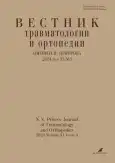Bone autograft collapse. Clinical case of the complication and clinical case of the solutions to this problem
- 作者: Chebotarev V.V.1, Ochkurenko A.A.1, Korobushkin G.V.1
-
隶属关系:
- N.N. Priorov National Medical Research Center of Traumatology and Orthopedics
- 期: 卷 31, 编号 3 (2024)
- 页面: 407-414
- 栏目: Clinical case reports
- URL: https://bakhtiniada.ru/0869-8678/article/view/290885
- DOI: https://doi.org/10.17816/vto623878
- ID: 290885
如何引用文章
全文:
详细
BACKGROUND: The issue of full-thickness osteochondral defect replacement in the talus is highly relevant. Bone autografting has proven effective in treating patients with this pathology, but the method has its drawbacks. The implantation of two or more bone autografts in large osteochondral defects may result in reduced contact strength between the donor bone and the recipient’s surrounding bone, leading to the formation of cysts and autograft instability.
Clinical cases description: We present two clinical cases for your consideration. In the first case, chondroplasty of the talus was performed with mosaic implantation of bone autografts. Six months later, due to instability of the bone autograft accompanied by pain, ankle joint arthrodesis was performed. Six months postoperatively, the pain score on the VAS scale decreased from 7/10 to 3/10, the AOFAS score was 74/100, and the FAAM score was 70/84. In the second clinical case, a modified mosaic chondroplasty using AMIC technology with provisional fixation of bone autografts with a pin was performed. Six months later, CT scans showed osteointegration of the bone autografts without the formation of subchondral cysts. The questionnaires also demonstrated positive dynamics: the VAS score decreased from 7/10 to 1/10, the AOFAS score improved from 70/100 to 90/100, and the FAAM score increased from 72/100 to 83/84.
CONCLUSION: The leading criterion for a successful bone autograft procedure is the stability of the autograft, which is achieved through adequate graft length and secure fixation. The proposed method of provisional fixation of the bone autograft with a pin during mosaic chondroplasty is a reproducible, effective, and cost-efficient technique that ensures the stability of the bone autograft and maintains its press-fit contact with the talus.
作者简介
Vitaliy Chebotarev
N.N. Priorov National Medical Research Center of Traumatology and Orthopedics
编辑信件的主要联系方式.
Email: chebotarew.vitaly@gmail.com
ORCID iD: 0009-0001-6483-3162
MD
俄罗斯联邦, 10 Priorov str., 127299 MoscowAleksandr Ochkurenko
N.N. Priorov National Medical Research Center of Traumatology and Orthopedics
Email: cito-omo@mail.ru
ORCID iD: 0000-0002-1078-9725
SPIN 代码: 8324-2383
MD, Dr. Sci. (Medicine), рrofessor
俄罗斯联邦, 10 Priorov str., 127299 MoscowGleb Korobushkin
N.N. Priorov National Medical Research Center of Traumatology and Orthopedics
Email: kgleb@mail.ru
ORCID iD: 0000-0002-9960-2911
SPIN 代码: 9715-1063
MD, Dr. Sci. (Medicine)
俄罗斯联邦, 10 Priorov str., 127299 Moscow参考
- Hurley ET, Murawski CD, Paul J, et al.; International Consensus Group on Cartilage Repair of the Ankle. Osteochondral Autograft: Proceedings of the International Consensus Meeting on Cartilage Repair of the Ankle. Foot Ankle Int. 2018;39(1_suppl):28S–34S. doi: 10.1177/1071100718781098
- de l’Escalopier N, Barbier O, Mainard D, et al. Outcomes of talar dome osteochondral defect repair using osteocartilaginous autografts: 37 cases of Mosaicplasty®. Orthop Traumatol Surg Res. 2015;101(1):97–102. doi: 10.1016/j.otsr.2014.11.006
- Guney A, Yurdakul E, Karaman I, et al. Medium-term outcomes of mosaicplasty versus arthroscopic microfracture with or without platelet-rich plasma in the treatment of osteochondral lesions of the talus. Knee Surg Sports Traumatol Arthrosc. 2016;24(4):1293–1298. doi: 10.1007/s00167-015-3834-y
- Savage-Elliott I, Smyth NA, Deyer TW, et al. Magnetic Resonance Imaging Evidence of Postoperative Cyst Formation Does Not Appear to Affect Clinical Outcomes After Autologous Osteochondral Transplantation of the Talus. Arthroscopy. 2016;32(9):1846–54. doi: 10.1016/j.arthro.2016.04.018
- Wan DD, Huang H, Hu MZ, Dong QY. Results of the osteochondral autologous transplantation for treatment of osteochondral lesions of the talus with harvesting from the ipsilateral talar articular facets. Int Orthop. 2022;46(7):1547–1555. doi: 10.1007/s00264-022-05380-7
- Feeney KM. The Effectiveness of Osteochondral Autograft Transfer in the Management of Osteochondral Lesions of the Talus: A Systematic Review and Meta-Analysis. Cureus. 2022 Nov;14(11):e31337. doi: 10.7759/cureus.31337
- Shimozono Y, Hurley ET, Myerson CL, Kennedy JG. Good clinical and functional outcomes at mid-term following autologous osteochondral transplantation for osteochondral lesions of the talus. Knee Surg Sports Traumatol Arthrosc. 2018;26(10):3055–3062. doi: 10.1007/s00167-018-4917-3
- Kreuz PC, Steinwachs M, Erggelet C, et al. Mosaicplasty with Autogenous Talar Autograft for Osteochondral Lesions of the Talus after Failed Primary Arthroscopic Management. The American Journal of Sports Medicine. 2006;34(1):55–63. doi: 10.1177/0363546505278299
- Latt LD, Glisson RR, Montijo HE, Usuelli FG, Easley ME. Effect of graft height mismatch on contact pressures with osteochondral grafting of the talus. Am J Sports Med. 2011;39(12):2662–2669. doi: 10.1177/0363546511422987
- Muradyan DR, Kesyan GA, Levin AN, et al. Surgical Treatment of Talus Osteochondral Lesions with Platelet-Rich Plasma. N.N. Priorov Journal of Traumatology and Orthopedics. 2013;20(3):46–50. doi: 10.17816/vto201320346-50
- Rodionova SS, Lekishvili MV, Sklyanchuk ED, et al. Prospects for Local Application of Antiresorptive Drugs in Skeleton Bone Injuries and Diseases. N.N. Priorov Journal of Traumatology and Orthopedics. 2014;21(4):83–89. doi: 10.17816/vto20140483-89
- Mittwede PN, Murawski CD, Ackermann J, et al.; International Consensus Group on Cartilage Repair of the Ankle. Revision and Salvage Management: Proceedings of the International Consensus Meeting on Cartilage Repair of the Ankle. Foot Ankle Int. 2018;39(1_suppl):54S–60S. doi: 10.1177/1071100718781863
补充文件















